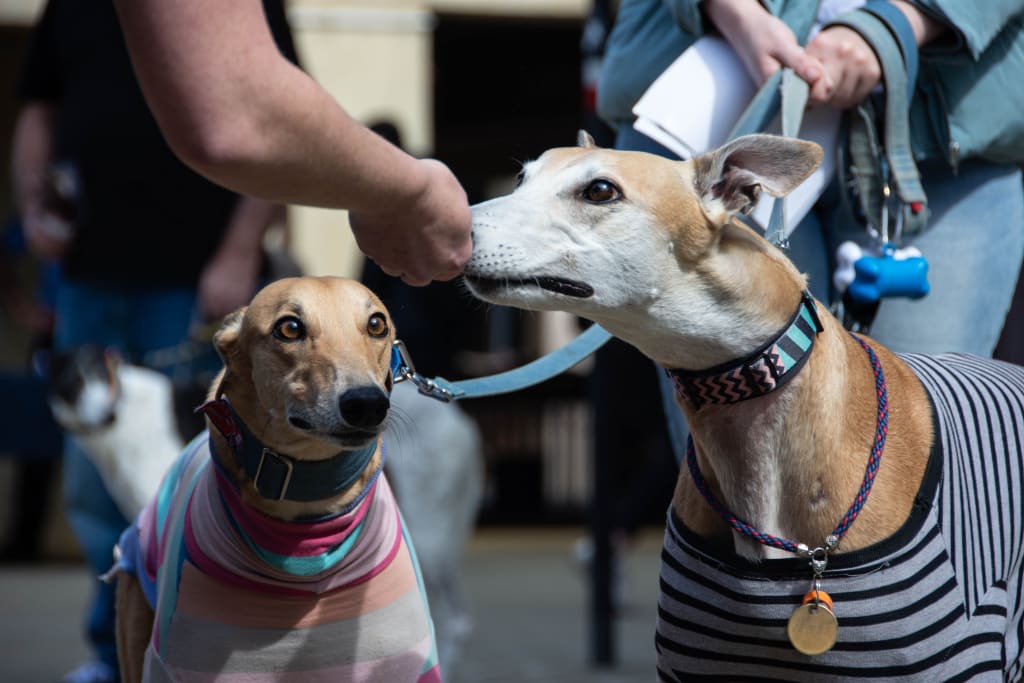7 UNIQUE FACTS ABOUT DOGS YOU PROBABLY DON'T KNOW
Going beyond the obvious: uncovering unique dog characteristics

Dogs are some of the most beloved animals in the world. They are loyal, friendly, and incredibly intelligent, making them great companions and family members. Although we think we know all there is to know about these furry four-legged friends, there is still much to learn about these amazing animals. Here are seven unique facts about dogs you probably didn't know!
CLICK HERE TO WATCH A FREE YOUTUBE VIDEO ON DOGS
1) Dogs have a great sense of smell
Dogs have an incredible sense of smell and this is one of their most highly developed senses. Dogs have about 200 to 300 million scent receptors in their noses, compared to the 5 million found in humans. This makes dogs up to 100,000 times more sensitive to smells than humans! Dogs are able to distinguish smells from far away, allowing them to sense danger or catch prey even when they’re a great distance away. Dogs can even be used to track down wild animals or pets that have gone missing. Many search and rescue organizations use trained dogs to detect scents in remote areas that would otherwise be difficult to find. As an example, sniffer dogs have been used by police forces all over the world to help detect illegal items such as drugs, explosives and firearms. Furthermore, some wild dog breeds, like dingoes, can also be kept as pets. While dingoes aren't considered traditional domestic pets, many people do keep them as companions due to their loyalty and intelligence. Unfortunately, as with all wild animals, dingoes require careful handling and training for them to become safe pets. In addition to being able to help humans find lost pets and items, some dogs also possess a special ability known as ‘pigment detection’ which allows them to tell if another animal has had recent contact with another wild animal such as a fox or rabbit.
CLICK HERE TO WATCH A FREE YOUTUBE VIDEO ON DOGS
2) Dogs are very intelligent
Dogs are widely recognized for their intelligence, and it’s no wonder why. It’s estimated that the average dog can understand around 165 words and commands, which is more than a two-year-old child! Not only do they understand commands, but dogs can also recognize emotions in humans and other animals. Dogs are known to be able to differentiate between their owners’ happy and angry tones. This ability to recognize emotions is what allows dogs to be so good at therapy work, service work, and even police work. Some of the smartest breeds include Border Collies, Poodles, German Shepherds, Golden Retrievers, Doberman Pinschers, and Rottweilers.
CLICK HERE TO WATCH A FREE YOUTUBE VIDEO ON DOGS
3) Dogs can be trained to do tricks
Dogs are incredibly intelligent and can learn all kinds of tricks. Many people use positive reinforcement to train their dogs to do a variety of fun things. This can include basic commands such as “sit”, “stay”, “come” and more. Dogs can also be trained to perform more complex tricks such as rollover, play dead, shake paws, fetch, and even open doors.
Some owners choose to take their training a step further and enroll their dogs in dog sports such as agility or dock diving. These sports require intense obedience training and dedication from both the handler and the dog. For example, agility involves obstacle courses where the dog must run through tunnels, jump over hurdles, weave through poles, and complete other tasks in a timely manner. Dock diving requires the dog to dive into a pool of water and retrieve an object.
No matter what kind of trick you want to teach your pup, it’s important to use positive reinforcement when training your dog. This means rewarding your pup with treats or verbal praise when they do something correctly. With consistency and patience, you can teach your dog some amazing tricks that will provide endless hours of entertainment for you both!
CLICK HERE TO WATCH A FREE YOUTUBE VIDEO ON DOGS
4) Dogs can be used as service animals
Service animals are trained to assist individuals with disabilities and are vital companions to those who need them. Dogs are the most common type of service animal, and they have been used in this capacity for centuries. Service dogs help people with a variety of tasks, from providing physical assistance to providing emotional support.
The Americans with Disabilities Act (ADA) defines a service animal as any dog that is individually trained to do work or perform tasks for the benefit of an individual with a disability. Service animals are not considered pets, but working animals and must be allowed in public areas like stores, restaurants, and other businesses. They are usually trained to perform specific tasks that their handler cannot do, such as picking up objects, opening doors, pulling wheelchairs, alerting to medical conditions, and more.
In addition to physical tasks, service dogs can also provide emotional support for their handlers. They are excellent listeners, often sensing when someone needs comfort and responding in a comforting way. Service dogs also help to reduce stress, loneliness, and anxiety levels.
Using service dogs is an effective way to help those with disabilities and provide them with greater independence. If you or someone you know has a disability and could benefit from the use of a service animal, contact a professional to learn more about how a service animal can help.
CLICK HERE TO WATCH A FREE YOUTUBE VIDEO ON DOGS
5) Dogs can be used in law enforcement
Dogs are not only loyal and loving companions, but they also possess great intelligence and strength which makes them invaluable assets in law enforcement. Dogs have long been used by police officers and other law enforcement personnel as a method of tracking suspects and detecting contraband. Dogs can be trained to recognize the scent of illegal drugs, explosives, and even weapons, making them an invaluable tool in the fight against crime. Dogs can also be trained to apprehend suspects, providing an additional layer of protection for officers. The presence of a dog can also act as a deterrent to potential criminals, reducing the risk of officers coming into harm’s way. Additionally, the loyalty and intelligence of dogs can make them important members of any law enforcement team.
CLICK HERE TO WATCH A FREE YOUTUBE VIDEO ON DOGS
6) Dogs can be used in therapy
Dogs have the special ability to offer companionship and comfort. As a result, they can be used in therapeutic settings to help those suffering from a range of physical and mental health issues. Therapeutic dog visits are often used in hospitals, nursing homes, schools, counseling centers, and even prisons. They can provide much-needed support for people experiencing depression, anxiety, loneliness, PTSD, autism, and other conditions.
Therapy dogs are specially trained to interact with people in a positive manner. They are friendly, patient, and gentle creatures that can provide the perfect amount of comfort to individuals who need it most. They don’t require any particular words or phrases to be spoken and can communicate with simple gestures such as licking a person’s hand. This type of therapy helps patients to feel more at ease and allows them to open up and express their emotions in a safe environment.
Studies have also shown that interacting with therapy dogs can lower stress levels, improve self-esteem, and create an overall calming effect on individuals. For this reason, many mental health professionals recommend therapy dogs as a form of treatment for their patients.
CLICK HERE TO WATCH A FREE YOUTUBE VIDEO ON DOGS
7) Dogs can be used in search and rescue
Search and rescue dogs are a valuable asset to our society. They are used to help find missing persons, or to provide assistance in natural disasters. Dogs are especially well-suited for this task due to their strong sense of smell, their ability to traverse difficult terrain, and their overall intelligence.
Search and rescue dogs are specifically trained for this line of work. They must be able to understand commands from their handler and know how to search for specific scents. In addition, they must be able to distinguish between different types of scents and track down even the faintest of smells.
The most common type of search and rescue dog is a specially trained tracking dog. These dogs are taught to follow a scent over long distances, and they can cover up to ten miles in one hour. They are also able to detect human remains and alert their handlers when they’ve found something. In some cases, these dogs are even able to identify specific individuals.
Aside from tracking, search and rescue dogs can also be used in water rescue operations. They are taught how to navigate through rivers and lakes, and they can detect any person who may have gone missing in the water. Dogs can also be used in avalanche rescue operations due to their ability to locate buried individuals.
All in all, search and rescue dogs are a great asset to any search and rescue team. They are incredibly intelligent and capable animals, and they have proven themselves time and time again in times of need.
CLICK HERE TO WATCH A FREE YOUTUBE VIDEO ON DOGS
Conclusion
Dogs are truly amazing animals and their unique abilities have been a benefit to mankind for centuries. They have an amazing sense of smell, they are highly intelligent, and they can be trained to do many incredible things. Dogs have been used as service animals, in law enforcement, in therapy, and in search and rescue operations. Their loyalty and dedication to their owners is unparalleled, and they make great companions. Next time you’re out with your pup, take the time to appreciate all of the unique qualities that make them so special!
About the Creator
Ahmad Mubarak Muhammad
Mubarak: a curious wordsmith and traveler, exploring life's mysteries and sharing stories of adventure, growth, and inspiration. Join me on my journey of self-discovery and creative expression.
Enjoyed the story? Support the Creator.
Subscribe for free to receive all their stories in your feed. You could also pledge your support or give them a one-off tip, letting them know you appreciate their work.






Comments
There are no comments for this story
Be the first to respond and start the conversation.